Guitar 905 – Gallery
July 1, 2010
Guitar 905 photo gallery. Headstock design came from client.
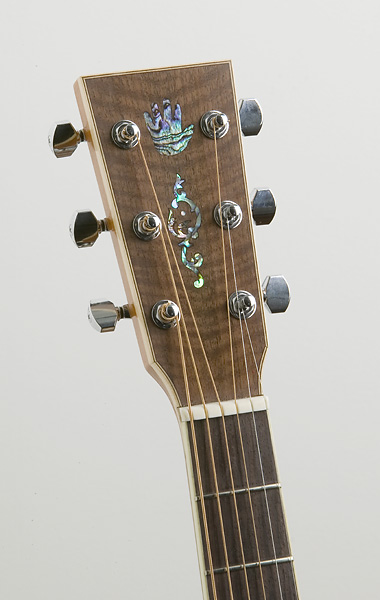
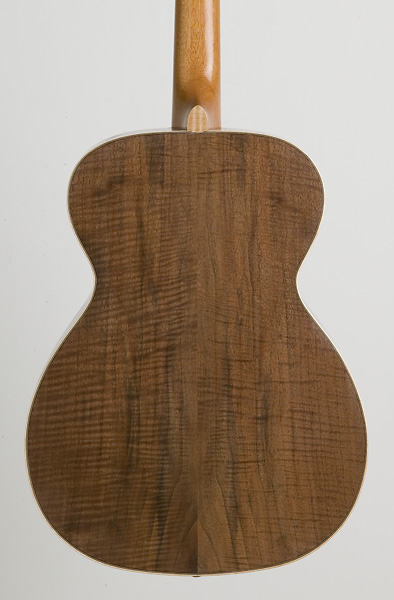
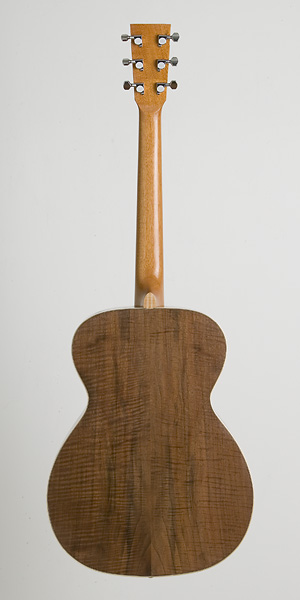
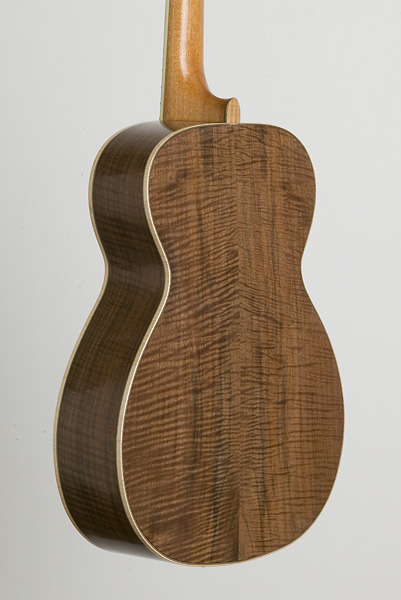
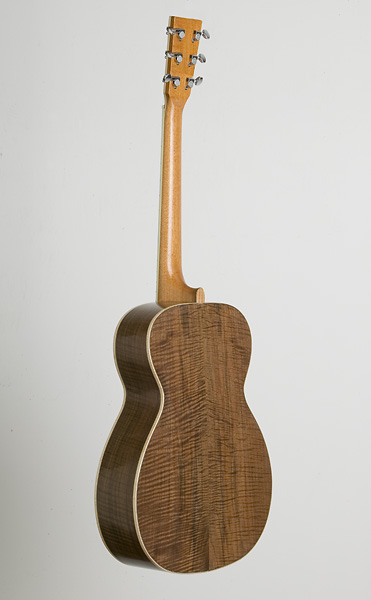
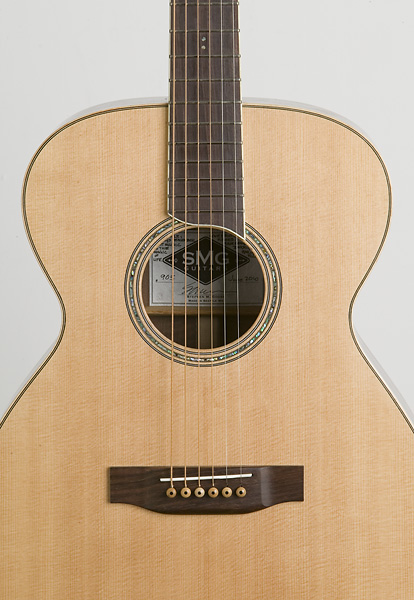
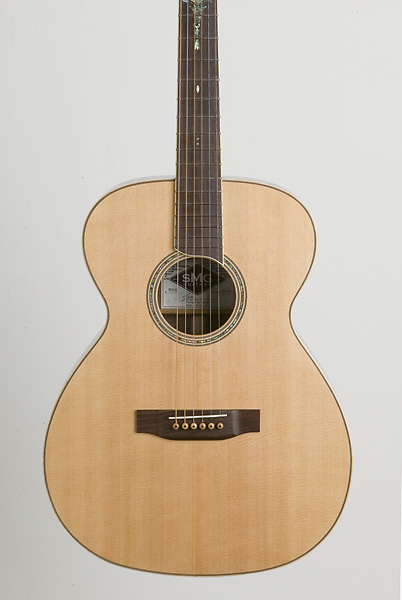
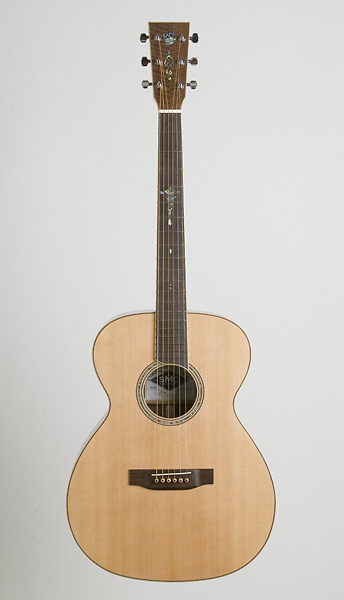
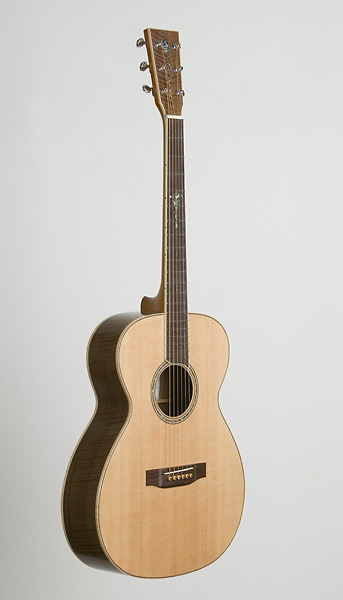
July 1, 2010
Guitar 905 photo gallery. Headstock design came from client.









July 1, 2010
Photos of Guitar 906. Very proud of the inlay.
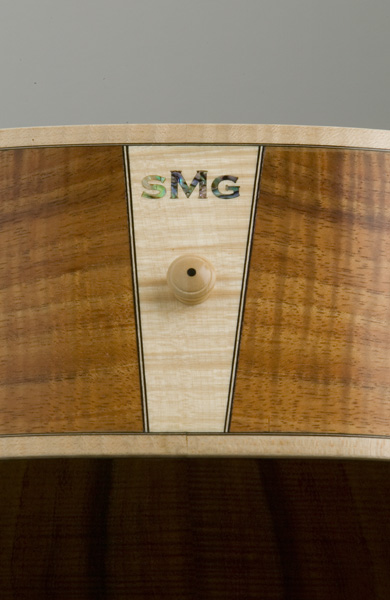
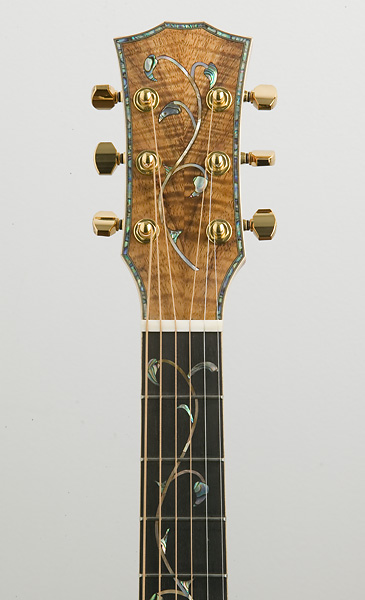
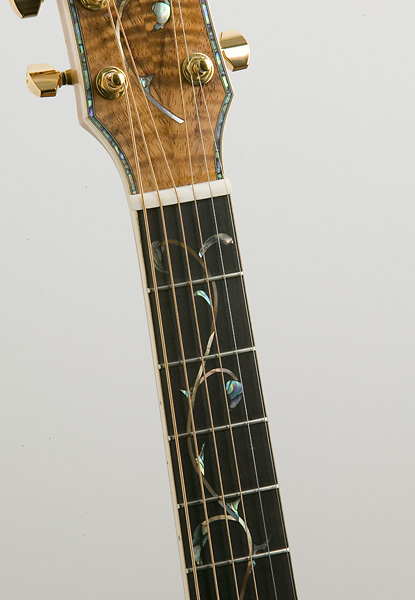
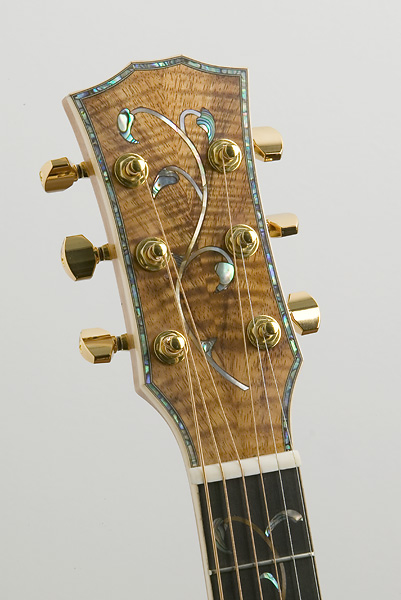
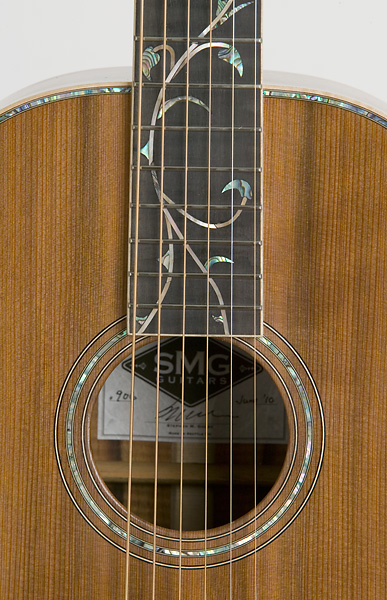
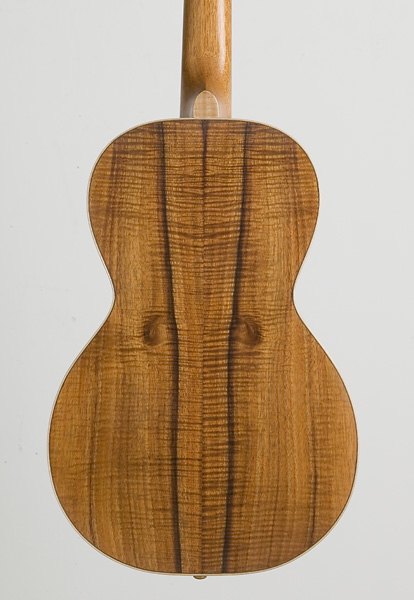
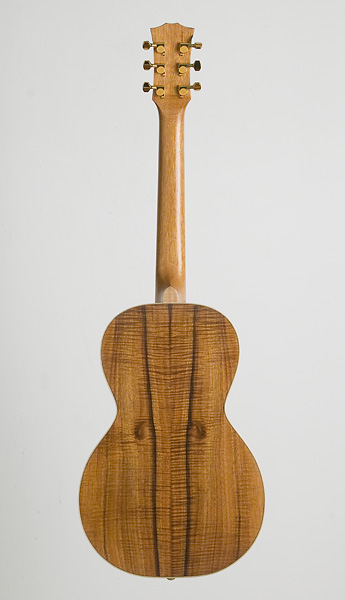
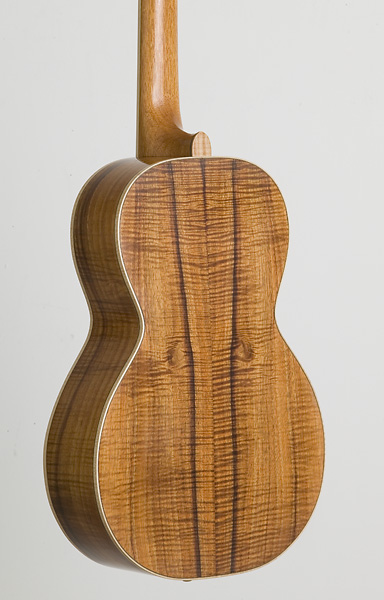
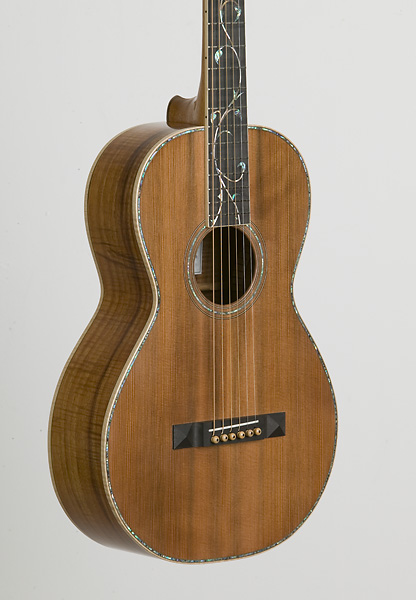
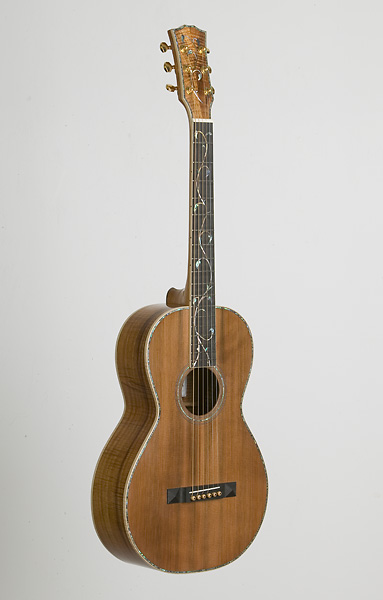

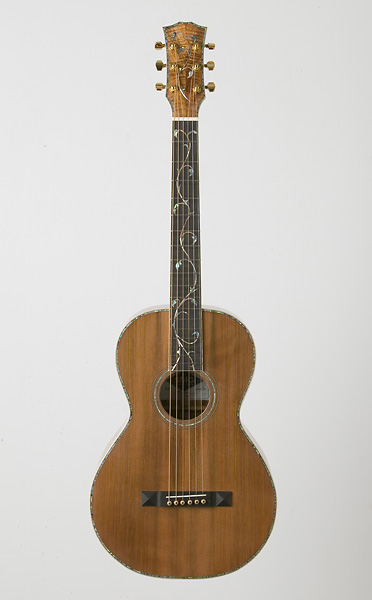
July 1, 2010
The year is half gone and two completed guitars have gone out the door. One guitar is in process, and there’s grand plans to start building ukes. I’ve also got my sights set on building a guitar modelled after a Gibson L-00. The Uke and Gibson project requires the building of molds, templates and jigs.
I’ve got a handful of repairs in the backlog which I’ll have to balance with the new construction. I’m wrapping up the neck reset for the Gretsch New Yorker, and I have several major overhauls which have been waiting for an opening.
I’ve finished rebuilding the router table, and have designed a jig for brace radiusing. I’m looking into CNC tools and software as a side opportunity. CNC could be a valuable skill/tool especially if I begin to productionalize the building process through repeatable construction processes.
All this and I’m starting a program called Alt Routes to Secondary Mathematics Certification. Translation: High School math teacher. The program begins July 12. Summer courses end early August, then I dive into a school year long internship at a local high school. By the end of the school year, next June, I should be certified.
June 24, 2010
Tomorrow, Tom does his photo documentation of these guitars as the final step before turning them over to their owners. Carl picks up 906 on Saturday, and I ship 905 to John on Monday. I have lots of time to play them before they go on their way.
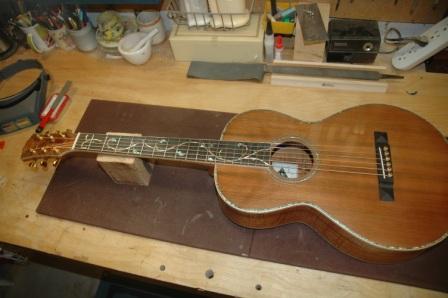

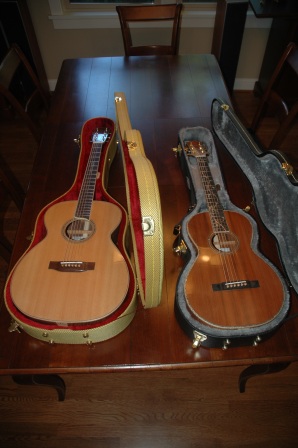
June 22, 2010
Well, nothing is ever really complete, but I can semi-safely say that guitars 905 and 906 are complete. Of course there’s still that buff this and tweak that and maybe there’s a little buzz on the 7th fret second string that I could frizzle out, but oh my, they are done.
There’s a lot I can say about each, but essentially I’m very pleased with the sound. That’s the one thing you don’t know until you finally string them up and play them. Everything you do is directed toward how they will sound in the end (and of course how they play, but if they sound like crap, who cares how they play). Both these guitars sound like heaven. I’m still amazed, to this day, that you can get so much sweet sound out of a small box parlor. It’s not a room filling volume of sound, but rather a resonant sweet tone.
The OM continues to impress me with its’ fullness and subtlety. This guitar was walnut, and I very much like the warmth and sustain that walnut gives.
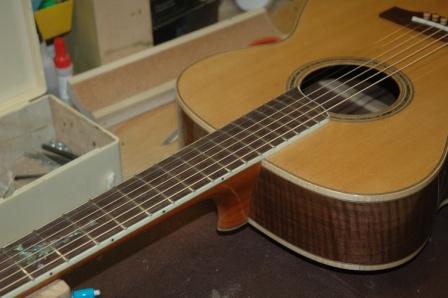
The parlor was my nth foray into Koa, and I am continually impressed with Koa as a guitar tonewood. Not only does it have beautiful visual quality, but it really sings, especially in the smaller body guitars.

So next is to do some polishing, label installing, and playing before I send these off to their respective owners.
Oh, and some other news…..even though I build guitars, I have to support myself and my family through the concept of a day job. I have been accepted into a program where I can get my secondary mathematics teaching certificate. Soon, I will be a high school math teacher.
June 15, 2010
I was in Dusty Strings Saturday picking up a few odds and ends and ogling the stock. I overheard that ukes are big sellers. The fastest growth in sales over any other item within the store. I’ve often considered building ukes, and get plenty of signals that this would be a good endeavor. Not that a uke would be that much faster to build (it’s just a tiny guitar after all), but there may be a larger market out there to support sales.
So, I’m on the hunt for some quality uke plans as a starting point, then going to look into what it would take to create a production line for quick turnaround.
June 15, 2010
Both the nut and saddle have been shaped in preparation for stringing up. I need to slot the bridge pin holes for the string entrance and notch the nut for the strings. Per the customer’s request, this is a very narrow neck at the nut. I’m excited to see how this narrow neck feels/plays.
June 15, 2010
After the neck set, I located the bridge position, masked off the surface and applied lacquer stripper to remove the lacquer in preparation for the bridge mounting.

This is still a process that I’m not fully comfortable with. As careful as one can be with the stripping of the lacquer, there is still a wee bit of contamination of the lacquer outside the area to be stripped. This can be seen at the edge of the bridge after mounting. It is so very slight, but still evident. Other approaches would be to mask the box where the bridge will go prior to spraying. Same goes for the neck/fretboard where it meets the upper bout.
Once the lacquer was removed and the surface roughed up, the bridge was glued and clamped in place.
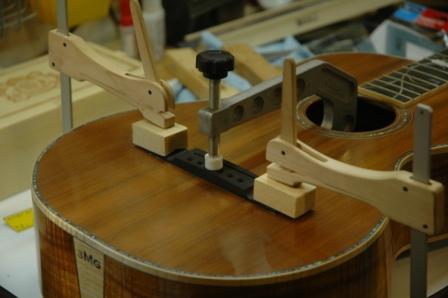
After it cures, bridge pin holes will be drilled and tapered in preparation for setup.
June 11, 2010
Carl comes to visit on the 25th. I have been the great pretender for too long. His guitar will be ready when he arrives. No excuses. I made a giant leap toward that goal today by knocking down that finish to a glorious sheen. The buffing wheel does wonderful things. I have learned, though, that there’s only so far that buffing wheel can hide incomplete sanding. And, I have learned how complete I must sand in order to buff to my desired finish.
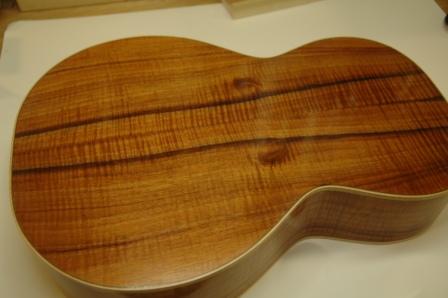
I have also learned the importance of grain filling. As I tend to finish on the light side (too much lacquer effects the sound, yet too much lacquer hides all blemishes), I can see every leftover crease, unfilled grain-ule, and divot from the sharp edge of the bench vise. Grain filling is that step before finishing where you level off the surface with a filler, and with most tropical hardwoods, there is a bit of open grain. Since I don’t rely on the final finish to fill the grain, I must be much more diligent in my grain filling step(s). I will not, I repeat, I will not proceed to the finishing step until every grain has been filled and leveled.
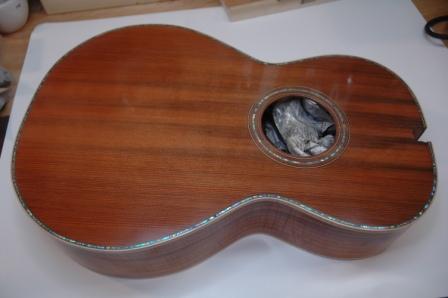
Now, the guitar in question, Carl’s Koa Parlor, does have a very interesting “grain feature”. The finish is not glass smooth, but accented with the natural grain of the wood. Visually it is pleasing (unless you want glass), but tonally, it will be for the best, as the lacquer is just enough to protect, but not enough to deflect from the sound the wood wants to make.
After buffing, I dry set the neck and checked the neck angle and masked the area arount the end of the fretboard where it will be glued to the top. The neck angle on this guitar is much closer to my preferred than any previously. What that means is that no matter how diligent I may be determining the neck angle, after all comes together and it’s time to install the neck, it’s always a little steeper than I planned. This guitar, a victim of multiple neck angle experiments, is much closer to ideal.
Strypeeze is used to remove the lacquer from the top where the fretboard will be glued. The following picture is a product placement, from which I have been handsomely compensated.
Once the goop has been carefully scraped away and neutralized with water, the neck can be glued to the body. I use a mortise and tenon bolt on neck, but the surface of the guitar top is glued to the fretboard for stability. This means that in future neck resets, only the section of the neck attached (glued) to the top needs to be heated and relieved.
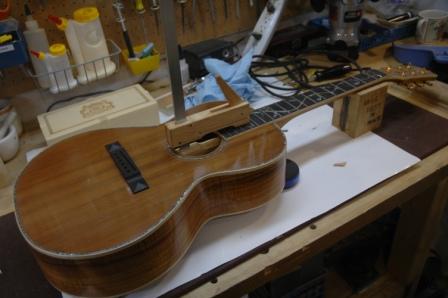
June 10, 2010
A lot of time this week has been spent on the building of a router table. I have a router table that sat in my garage (the room for all my power tools) and was made of MDF which sat directly under the largest leak in the garage. Needless to say, there are several leaks in my garage (circa 1910, cracked concrete, mostly below ground level). All sorts of effort has been made to stop the leaks, but none successfully. I’ve resigned myself to draping plastic garbage bags over all my power tools. The MDF router table was unusable as it bulged from all the absorbed water over the past year. I used it as a template and constructed a new one out of 3/4″ birch ply finished with lacquer.
I’ve been aware for some time that a router table with certain jigs is used quite a bit in luthier’s shops. The first use is to radius bracing. By building a jig that holds the brace blanks and has interchangeable radius templates, one can quickly and accurately radius braces and tonebars. I’ve designed the jig, but haven’t constructed as of yet. My design will allow for any width of brace and any radius that I have a template for (right now I have 40, 28, 20, 15, and 12). I use 28 for the top and 15 for the back on my current guitar models.
I’ll post a few pics of the router table and jig once complete.